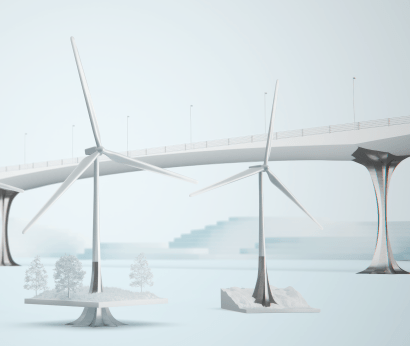
The innovative new design involves creating a series of long, curved beams out of recycled steel; and anchoring them to the ground in a design that mimics the way a tree's roots bury into soil.
STILFOLD estimates the method could significantly reduce the environmental impact of building wind turbines, by omitting the use of concrete and optimizing how wind turbine foundations are transported and constructed on site to minimize their environmental footprint.
The estimated Climate Performance Potential of the STILFOLD design over the next 5 years is 8.8 megatons; which is equivalent to 25% of Sweden's annual CO2 emissions.
How the STILFOLD design works
STILFOLD's pioneering wind turbine design involves cutting several long triangular pieces of steel from a large flat sheet; and folding each piece down the centre to create a series of tall, tent-shaped three-dimensional beams.
Each beam would be designed and constructed according to site-specific conditions following a ground scan, using STILFOLD's patented computer-guided software and "industrial origami" manufacturing technology. The technology involves the use of robotic arms to fold steel over curves to form light, strong and sustainable new structures with minimal component parts.
The triangular beams would be placed side-by-side and twisted together (similar to a piece of rope), before being bonded to form a tall, strong and durable foundation that curves outwards at the bottom like a root structure.
The bottom of each of the beams would be anchored to the ground individually for improved stability, mimicking the roots of a tree.
The design provides a robust, adaptable structure suitable for various ground conditions; and could also be adapted to construct the foundation of other outdoor structures such as buildings and bridges.
STILFOLD will be working with European partners to commercialize the design this year.
Jonas Nyvang, CEO and co-founder at STILFOLD, comments, "The foundation of an onshore wind turbine in the 7-8MW range is constructed using over 1000m3 of concrete and 150 tons of steel reinforcement. This creates a number of challenges: economical (costs are huge), logistical (it's not easy to produce and transport such high quantities of materials, it needs 100 truck-loads) and technical (it's difficult to deploy such a high volume of concrete).
"Our new design solution offers a cost-efficient and environmentally-friendly way of building the foundation of wind turbines, by reducing the amount of concrete required to anchor wind turbines in place. It also eases the logistical burden of wind turbine construction by enabling modular construction: the STILFOLD beams can be transported individually and assembled on site."
Christian Engene, Sustainable Design Strategist at Remanufaktur, comments, "The renewable energy transformation will require about 12,000 land-based wind farms to be built in the next five year period. STILFOLD enables a more sustainable way of manufacturing, completely removing the need for concrete.
"STILFOLD uses the latest low carbon steel manufacturing technology with the potential to reduce environmental impact by 80% from existing designs. The total Climate Performance Potential could save over 8 megatonnes of CO2 in the next five year period of wind power expansion."
STILFOLD's sustainable manufacturing technology has many potential applications. It is currently being used to build a fleet of sustainable steel electric motorbikes through sister company STILRIDE. The firm is also working with Polestar to build the world's first climate neutral car.

